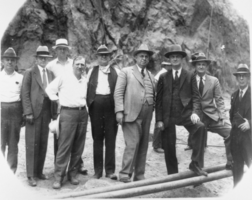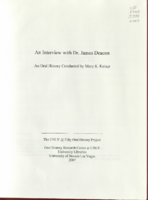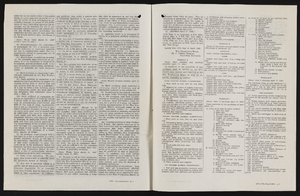Search the Special Collections and Archives Portal
Search Results

Film transparency of businessmen, politicians, and engineers at Hoover Dam, June 6, 1933
Date
Archival Collection
Description
Image
Jack Kent Tillar Papers
Identifier
Abstract
The Jack Kent Tillar Papers (approximately 1890-2010) are comprised of magic-related books, periodicals, pamphlets, ephemera, and artifacts from the estate of Jack Kent Tillar who was a composer and music editor for the film and television industry. Materials also include a small amount of Tillar's personal papers. Tillar was an amateur mentalist magician and wrote numerous books and articles on the subject of telepathy and mentalism including
Archival Collection
Sidney R. Whitmore Collection
Identifier
Abstract
The Sidney R. Whitmore Collection (approximately 1885-1970) contains land deeds and other documents about Mount Diablo, Nevada; documents detailing parts of his family history; and eight framed paintings of landscapes and portraits.
Archival Collection

Transcript of interview with Dr. James Deacon by Mary K. Keiser, August 24, 2006
Date
Archival Collection
Description
Text

Transcript of interview with Mary Laub by Wendy Starkweather, December 02, 2013
Date
Archival Collection
Description
Text

Kaity Webber oral history interview: transcript
Date
Archival Collection
Description
Oral history interview with Kaity Webber conducted by Barbara Tabach on November 16, 2017 for the Remembering 1 October Oral History Project. Kaity Webber describes moving to Las Vegas, Nevada and earning her degree in psychology from the University of Nevada, Las Vegas. Webber discusses the excitement she had going to the Route 91 Harvest festival with a friend on the weekend of the October 1, 2017 Las Vegas shooting. She talks about her experiences from that night, including how she found shelter in the Thomas & Mack Center with countless others, as well as her process of healing from the traumatic event.
Text

Transcript of interview with Unite Here Bartenders Union Local 165 by Claytee D. White, September 29, 2014
Date
Archival Collection
Description
Text

Interview with Bennie Reilley, Sr., May 10, 2004
Date
Archival Collection
Description
Access note: May not quote in any form without written permission from interviewee
Text

University of Nevada, Las Vegas (UNLV) Fall 2019 commencement program
Date
Archival Collection
Description
Commencement program from University of Nevada, Las Vegas Commencement Programs and Graduation Lists (UA-00115).
Text

